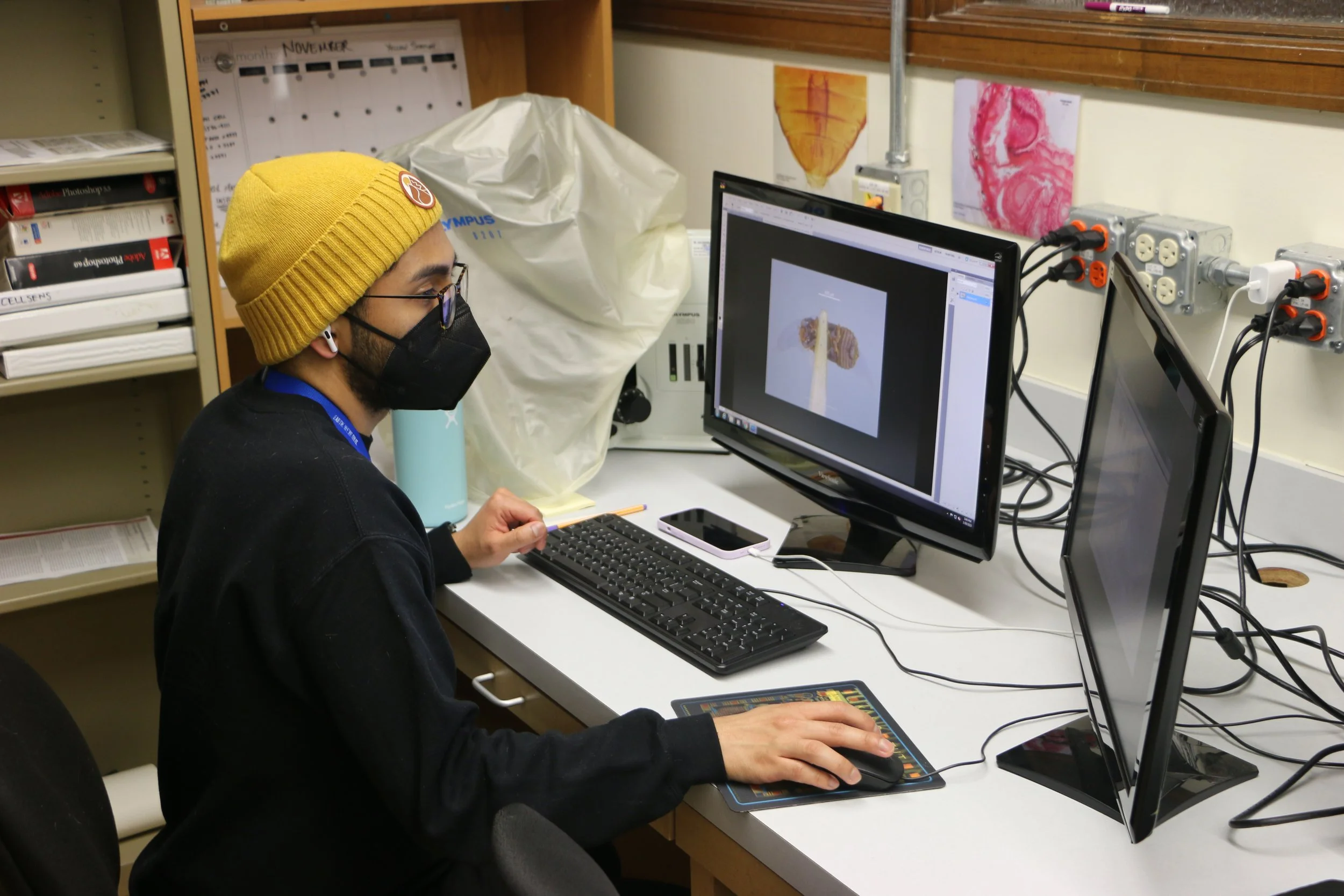PI
Bruno de Medeiros
Negaunee Assistant Curator of Pollinating insects
Bruno started his career as undergrad and MSc student at the University of São Paulo and then PhD student at Harvard University. After a pandemic postdoc at the Smithsonian Tropical Research Institute in Panamá, he has been at the Field Museum since September 2022. He is generally interested in the evolution of the outstanding insect diversity, and particularly of overlooked flower visitors such as beetles.
Staff
Andrew Gallardo
Collections Technician
Andrew is working at the insect collection in a grant funded by the Walder Foundation. He is currently photographing and digitizing insect specimens from which we will extract pollen. We will compare DNA metabarcoding to AI-assisted image classification as tools to identify the sources of pollen trapped in the bodies of these insects, which could unleash a wealth of possibilities for using insect collection to study the ecology and evolution of plant-flower visitor interactions.
Postdocs
Diego de Santana Souza
Diego is an evolutionary biologist interested in beetle systematics and evolution. He has experience using integrative taxonomy, genomics, and bioinformatics tools to investigate the origins of morphological and ecological innovations, such as the girdling behavior of longhorn beetles. His current projects aim to understand the mechanisms by which flower-associated beetle diversity arises, as well as to probe the role of mutualism and antagonism in macroevolutionary diversification, using the palm weevils as models. Diego is also involved in projects that aim to develop new methodologies for generating and analyzing phylogenomic data. These include generating genomic resources for studies of speciation in flower-associated beetles and tests of software-based adaptive sampling, such as target enrichment sequencing, using nanopore sequencing for phylogenetic studies, seeking to improve datasets by including samples that are only accessible by traveling.
Elizabeth Postema
Elizabeth is an ecologist, entomologist, and animal behaviorist fascinated by the many adaptive roles of animal coloration. She uses a variety of approaches to understand how diversity in color is produced and maintained, from conceptual reviews to experimental studies in the field. As a postdoctoral researcher at the Field Museum, she plans to take advantage of the museum’s rich Coleoptera collection to understand the evolution of beetle coloration on a global scale. Her project is specifically focused on how abiotic conditions (e.g. temperature and moisture) interact with biotic conditions (e.g. predator-prey dynamics, host-plant associations) to produce the striking diversity of color strategies we observe among beetles in nature. She is particularly interested in using whole-drawer imaging techniques, combined with Deep Learning AI models, to improve the speed and feasibility of specimen digitization and phenotyping.
Students
Abigail Magland
PhD Student
Abigail is a first-year PhD student at the University of Chicago in Evolutionary Biology. She is interested in beetle natural history and systematics and plans to explore how species interaction feeds diversity in flower-associated beetles. Her past work has focused on mosquito oviposition and beetle pollination behaviors through a combination of lab and field approaches. She holds a bachelor of science degree from Brigham Young University.
Maya Mahoney
Walder Intern
Maya is an Undergraduate student at DePaul University, with a concentration in Cellular and Molecular Biology. She is spending the summer assisting the Insects collection in an internship program funded by the Walder Foundation. She will be pulling pollen from historical specimens and comparing DNA metabarcoding and computer vision as methods to identify the plant source.
Volunteers
Alissa Doucet
Alissa is a graduate student at Northwestern University, studying the population genetics of an endangered, hawkmoth-pollinated plant. As an intern in the Insect Flower Visitors Lab, she is photographing and digitizing grasshopper specimens that will be used to study wing venation patterns using AI technology. She is broadly interested in plant-insect interactions and species conservation, with an emphasis on nocturnal pollinators. She plans to pursue future research focused on using environmental DNA (eDNA), museum specimens, and other non-lethal genomic sampling techniques as a tool for insect conservation.
Alumni
Aline Lira
CAPES visiting Phd Student
Aline is a PhD student at the Federal Rural University of Pernambuco with a keen interest in the systematics, evolution, and morphology of Curculionidae's adults and immatures. Her research aims to understand how the relationship between weevils and their host plants drives the diversification of these beetles over time. She is currently visiting the Field Museum, funded by Capes, to work on two projects. The first project involves the taxonomic revision of the genus Udeus (Curculioninae, Eugnomini). The second project aims to create the first molecular phylogeny for the entire tribe. Udeus, like other eugnomines, is associated with flowers, feeds on floral tissues, and develops inside the inflorescences of its host plants. Aline is also leading a collaboration to build a species-level molecular phylogeny of the tribe Eugnomini, which is found in the Australian and Neotropical regions. These studies will contribute to the taxonomic stability of Eugnomini and help to understand their biogeographic history.
Eduardo Gomyde
FAPESP visiting MSc Student
Eduardo is a graduate student at the University of São Paulo, Brazil, with a keen interest in Taxonomy, Systematics, and Morphology of beetles. He uses the family Leiodidae as a model to conduct his research. Currently, Eduardo is focused on the taxonomic revision of a leiodid genus named Paulipalpina. He is also spending six months at the Field Museum to compare morphological characters among Paulipalpina and other genera of the same tribe. His aim is to understand the series of modifications that occurred, especially on its genitalia. Eduardo's work primarily involves taking and analyzing SEM images to compare the fine morphological structures that allow for differentiation and grouping of species.







